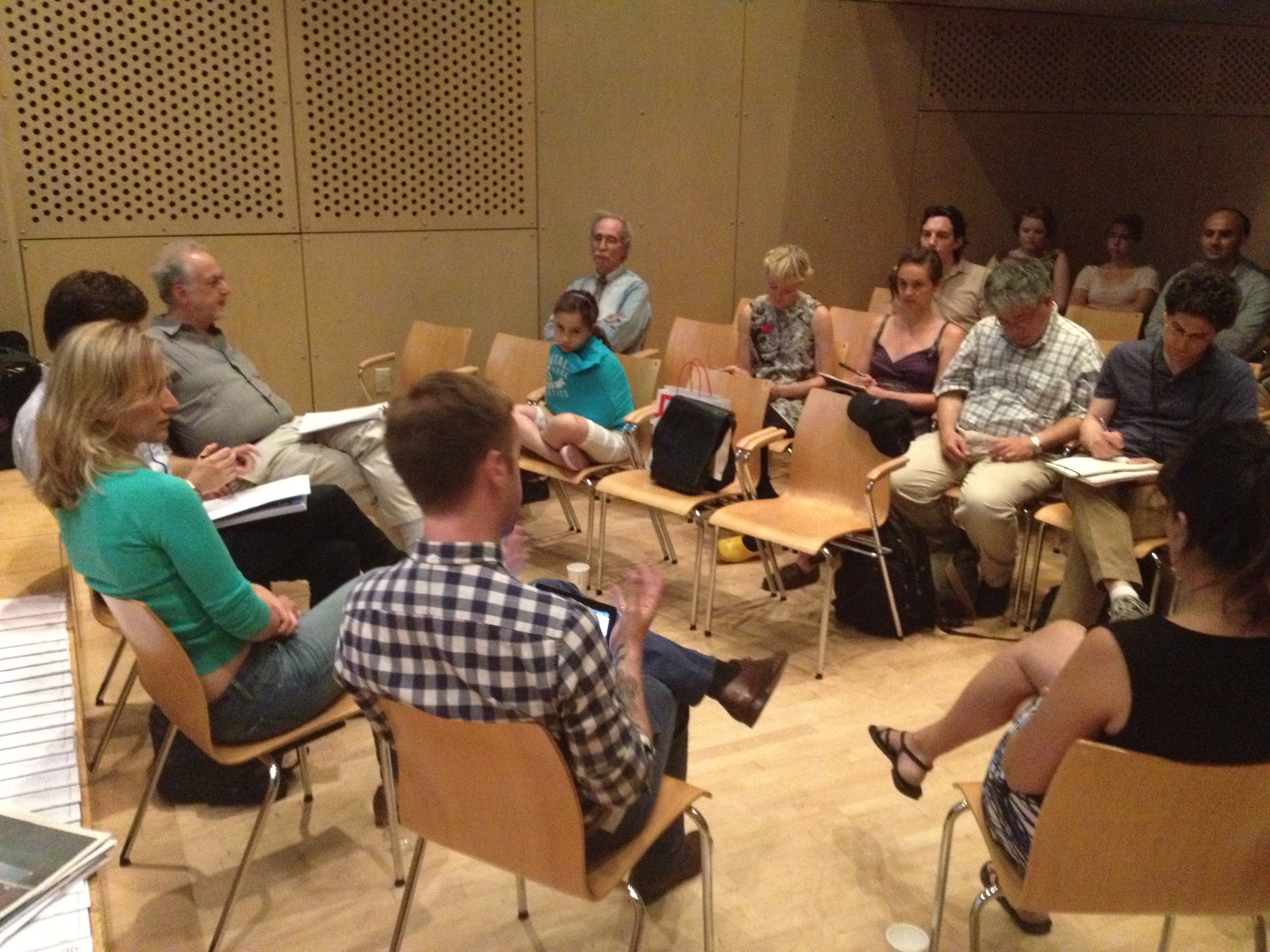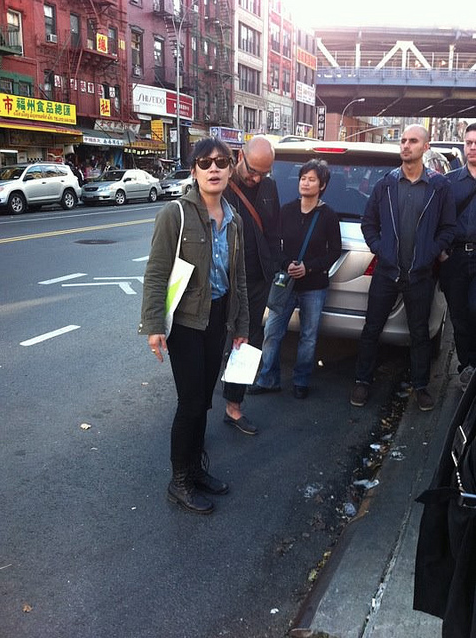DSGN AGNC aims to actively engage in community processes by creating and participating in platforms for broader political, social and design discourse with events, workshops, strategy meetings, etc. The goal is to create critical discourse and actions that lead to designs that affect the systems that shape communities and ecologies.
INDEX
Featured Events
The Critical and Activist Practice: A Discussion
MEDIA AS TACTIC: from print to practice
Beyond Occupation Walking Tour
A Call to Action for the Rights of the Neighborhoods
The Critical and Activist Practice: A Discussion
The conversation explored the question of what it means to be Critical and Activist in the context of design/art/architecture/urban practices. As practices increasingly engage social and environmental issues the question remains as to how to effectively work within the fragmented, decentralized and often weakened fiscal and political structures that characterize the neo-liberal city. The panel discussed how designers can fully engage in political processes rather than accept short-sighted solutions and to be advocates for projects that go beyond token investments on ‘green’ and ‘social’. A publication regarding these topics can be seen in the Publications page.
Organized by DSGN AGNC
Strategist Practices: Identifying and Mapping Urban Conflict Speaker: Sarah Williams
Tactical Approaches: On Media and Quick Action Speaker: Daniel Latorre
Erase Autonomy: Blurring Disciplinary Boundaries Speaker: Paula Z Segal
Working With, not For: Community Participatory Processes Speaker: James Rojas
Designing Processes, not Products: No Outcome is Ever Final Speaker: Mabel Wilson, Columbia University
Moderator: Anthony W. (Tony) Schuman, NJIT
MEDIA AS TACTIC: from print to practice
The conversation centered around how different groups and organizations are using media as a tactic to advocate for change in the city, broaden the voices that are heard, and to apply pressure on official institutions. This is of particular interest as more media sources become available and the question turns from how we get information to what we, as a society, can do with it. Can media gain relevancy by creating opportunities for activism in both digital and physical space?
Organized by DSGN AGNC
Speakers:
Justin Fowler || Priscilla Grim || Diana Lind || Anthony Smyrski
Moderator: Michael Sorkin
Beyond Occupation Walking Tour
This walking tour looked at the spaces used for community organization and activist participation in the area directly adjacent to the Essex Market — New York’s Chinatown. The goal was to understand the practices for community organization and the role that space, urban infrastructure and architecture plays in those practices. Beyond resistance, these spaces and practices are creating opportunities for long-lasting community political involvement and change.
By: Quilian Riano of DSGN AGNC and Esther Wang of CAAAV
Part of programming for the Living as Form exhibit in New York City, October 2011.
A Call to Action for the Rights of the Neighborhoods
The following statements were read at the Friends Center and at Occupy Philly in Philadelphia’s City Hall grounds on Monday, October 10, 2011, in conjunction with the 2011 Design in Action conference.
“It is our duty now to begin to lay the plans and determine the strategy for rethinking the American Dream. We cannot be content, no matter how high that general standard of living may be, if some fraction of our people—whether it be one-third or one-fifth or one-tenth—is ill-fed, ill-clothed, ill-housed, and insecure. Communities in need are not free communities. People who are hungry and out of a job are the stuff of which dictatorships are made.”
This new social contract is based off of the historical model of the Second Bill of Rights that was delivered by Franklin D. Roosevelt on January 11, 1944, which this a quote from.
The right to a useful and remunerative job;
The right to earn enough to provide adequate food and clothing and recreation;
The right of every community to produce its own resources with a rate of return that will give it a decent dignity;
The right to enable an economy that is inclusive of the small, free from domination by monopolies at home or abroad;
The right of every family to a decent home;
The right to adequate medical care and the opportunity to achieve and enjoy good health;
The right to adequate protection from the economic fears of old age, sickness, accident, and unemployment;
The right to culture and a practical education.
Design AS Action
We demand that institutions of power rethink themselves together with communities;
We demand that the municipalities rethink their own fragmented bureaucratic silos and resources;
We demand accountability of municipalities to invest in marginal neighborhoods;
We demand the political and economic tools to develop our neighborhoods incrementally. We demand the political support to temporarily activate vacant spaces and to incubate new social organizations;
We demand the restructuring of tax credits, subsidy financing, and zoning codes to enable small and inclusive development;
We demand the power to deny developments that do not plan for social and economic benefit;
We demand the re-invention of housing beyond abstract units; We demand the rethinking of lending practices; We demand the taxing and accountability of the wealthy 1%;
We demand intelligent public spending on education, culture, and transportation;
We demand other forms of property, and the valuation of memory and social relationships;
We demand the right to culture and education, not as expendable commodities but as civic responsibilities;
We demand a new political language that includes public culture;
We, the undersigned,
Teddy Cruz, Aaron Levy, Diana Lind, Quilian Riano, Elizabeth Grimaldi, Sally Harrison, Aviva Kapust, Mimi Cheng, Megan Schmidgal, El Sawyer, Melissa J Frost.”
Collectively representing: Slought Foundation, Estudio Teddy Cruz, the Village of Arts and Humanities, Next American City, the Urban Workshop at Temple University, and DSGN AGNC.
10.25.12: PRESENTATION: Urban Intervention Camp at the School of Constructed Environments, Parsons The NewSchool of Design, 2012 VENICE BIENNALE
09.16.12: PRESENTATION: Beyond Zuccotti: Freedom of Assembly and Public Space Today at the Center for Architecture
09.08.12: ACTION/EVENT: Corona’s Plaza First Community Design Workshop/Taller de diseño communitario #1
08.30.12-09.01.12: ACTION/EVENT: Urban Intervention Camp, 2012 VENICE BIENNALE
08.29.12: EVENT/ACTION: As part of the #lgnlgn collective helped set up and frame questions for CITY SESSIONS: SPONTANEOUS TALK, 2012 VENICE BIENNALE
08.29.12: PANEL: The Image of the City at the American Pavilion, 2012 VENICE BIENNALE
08.22.12: PRESENTATION: Flux Factory DEATH MATCH
04.28.12: PRESENTATION: Next American City’s Tactical Urbanism Salon on DSGN AGNC and Critical Strategies and Meaningful Tactics.
04.01.12: PRESENTATION: What Belongs in a City? Discussion Panel.
10.16.11: ACTION: Led a “Beyond Occupation” tour of Chinatown with CAAAV for Living as Form
10.15.11: PRESENTATION: Participated in a panel at the Tactical Urbanism Salon
10.14.11: EVENT: Participated in the Storefront for Art and Architecture’s Architecture For Free
10.10.11: PRESENTATION: Presented on two panels at the Design in Action Conference
10.10.11: ACTION: Helped produce, craft, and deliver A Call to Action for the Rights of the Neighborhoods
09.15.11: EVENT: Worked as part of #LGNLGN with the IFUD to moderate the physical discussion of City Sessions
08.26.11: EVENT: Worked as part of #LGNLGN with the IFUD to moderate the online discussion of City Sessions
06.03.11-06.04.11: EVENT/ACTION: Worked on setting up social media and documenting the Political Equator
03.25.11: PRESENTATION: SFI 10+1 in Chicago
02.21.11: PRESENTATION: Harvard University’s GSD – What’s the FACA?
11.06.10: PRESENTATION: J. Max Bond Jr. Memorial Lecture: Conversations/Travel event at the Center for Architecture
09.20.09: PRESENTATION: DESIGN AS ACTIVISM at Cornell University








